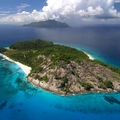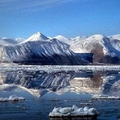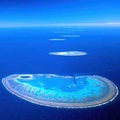The Indian Ocean
About the Indian Ocean
The Indian Ocean is the third largest ocean in the world and it covers 73 million square kilometers. This is the warmest ocean, rich in various flora and fauna. The deepest place in the Indian Ocean is the Java basin, located south of the island o...
|
The Oceans of the World -> World Tourism
About The Oceans of the World
Terra is the planet's oceans. Life depends crucially, more than ever, on the respect that people will have to the oceans. They are and will remain the cradle of life. A romance voyage with saturated air, breathing the sea air is a necessary condition for a quality rest. This improves the immunity of the person and receives a charge of vivacity enough for a few months. The sea air, rich in iodine salts, sodium chloride promotes cell regeneration and the slowing of the aging process. The sea calms, the sound of the waves, and the vast expanse of the water that a person can watch endlessly is good for our health. When combined with new experiences, excursions and trips, sea and ocean tours give a great therapeutic effect. The oceans and the seas, the rivers, the lakes and the streams cover 75% of the surface of our planet. The amazing underwater world attracts many travelers. In the past, a travel was associated with the seas and oceans. Geographical discoveries are inextricably linked with the travelers. The world knows them since the Middle Ages and starting the list with Columbus and ending with Heyerdalom and Jacques-Yves Cousteau.
Hydrosphere is the collection of all water bodies of the world: oceans , rivers , lakes , reservoirs, wetlands, groundwater, glaciers. Water is the basis of the hydrosphere, one of the most common chemical compounds on the Earth. This is the only substance that under natural conditions on the surface of our planet is found in solid, liquid or gaseous state. It is the main component of the living organisms. Water body is the permanent or the temporary concentration of the natural waters on the land surface or in rocks with distinctive forms of distribution and features of the regime. Water bodies are the seas, oceans, rivers, lakes, marshes, reservoirs, groundwater, and water channels, ponds and other places of constant concentration of water on the land surface (in the form of snow). The world ocean is the bulk of the hydrosphere, a continuous aqueous envelope of the earth surrounding the continents and islands distinguished by a salt composition. The oceans are regulators of the heat. Oceans are rich in food, mineral and energy resources.
The boundaries between oceans have been established by the International Hydrographic Organization , so the Antarctic Ocean coast extends from Antarctica to 60 degrees latitude. One billion people ( 17% of the population) depend directly on the ocean as the only source of protein. Between 70 – 80% of oxygen is produced by the oceans. The word ocean from the Greek “ Ωκεανός” , on behalf of the Greek god of the Ocean is the largest water body, a component of the World Ocean , located among the continents , which has a system of water circulation and other special features. The surface area of the world's oceans, which consist of oceans and seas is about 75 % of the surface of the Earth (about 361 million square kilometers). The science that studies the oceans is called oceanography . In 2000, the International Hydrographic Organization adopted a division into five oceans of the world .
However, later on the provision of a separate Southern Ocean refused, and it is now officially back on the Earth’s four oceans:
The Atlantic Ocean
Area: 91 million km 2
Size: 329.7 million km 3
Average depth: 3600 meters
Maximum depth: 8742 meters
The Indian Ocean
Area: 73 million km 2
Volume: 292.1 km 3
Average depth: 3890 meters
Maximum depth: 7725 meters
The Arctic Ocean
Area: 14 000 000 km 2
Volume: 18.1 km 3
Average depth: 1225 meters
Maximum depth: 5527 meters
The Pacific Ocean
Area: 169 million km 2
Size: 710 km 3
Average depth: 4280 meters
Maximum depth: 11 022 m
The largest of these is the Pacific Ocean, an area of approximately 169 million square km, the Atlantic Ocean, which area is 91 million square km is the third largest ocean, the Indian and the smallest ocean - the Arctic, an area of approximately 14 million square km. The oceans are deep waters. If the surface of the ocean is warmed up by the sun, at the depth, its temperature can fall and fall , even below -1 C. The water in all parts of the vast ocean is never quiet, constantly moving. Such movements of the water over long distances are called currents. The currents are of several types: superficial, deep and bottom. The main reason for the surface currents (drift) is a breeze. The sun, the chemical transformations and the attraction of the moon are reasons for the movement of water in the ocean. The colder or the saltier water . So, for example, when dealing with warm water, the cold goes into the depths. Thus deep and bottom currents can be formed. The Russian Admiral Makarov scientist discovered in the XIX century an undercurrent in the Bosporus. He found that the more saline waters of the Marmara Sea flows into the Black Sea current , less saline water is carried by the current from the Black Sea of Marmara. There are ocean currents that arise due to the inclination of the sea level. These include, in particular, to Florida for the Caribbean, which is formed as a result of the surge of the water over the surface in the Gulf of Mexico.
We cannot know the answer to the question about the formation of the seas and oceans on the planet. Some scholars suggest that they arose in the following way. After the appearance of the planet, the Earth was surrounded by a thick blanket of clouds. Gradually, the Earth cooled and long rains poured on the surface, which filled with water all the cavities in the earth's crust. Thus, the oceans and the seas were formed. Later, when the continents began to move, all moving from each other, the water began to fill the distance between them. So they formed the oceans, which are available now.
Vote the best in order to establish the winner in The Oceans of the World.
The Arctic Ocean
The Arctic Ocean- the realm of ice and silence
The Arctic Ocean, which lies between Canada and Siberia, is the smallest ocean on the planet. It is the most mysterious, because it is almost completely hidden under a huge layer of ice. The Arctic Ocean basin divides ...
|
The Pacific Ocean
In the XV century, people called it " the Great Ocean , " and it was already assumed that it is an ocean of boundless amount. And they were right, because the area of the Pacific Ocean is more than 178.620 million km ². It occupies half of the entire water surface of the Earth, and over thirty percent of the planet's surface. The Spanish conquistador Vasco Nunez de Balboa found the ocean fo...
|
The Atlantic Ocean
"The sea on which the Greeks float is called the Atlantic" , Herodotus wrote about the Atlantic Ocean. The Atlantic Ocean is the second largest ocean and it covers an area of 82 million square kilometers. It is almost two times less than the Pacific Ocean, but its size is constantly increasing. From the island of Iceland to the south in the middle of the ocean extends a po...
|
Pag 0 of 1













